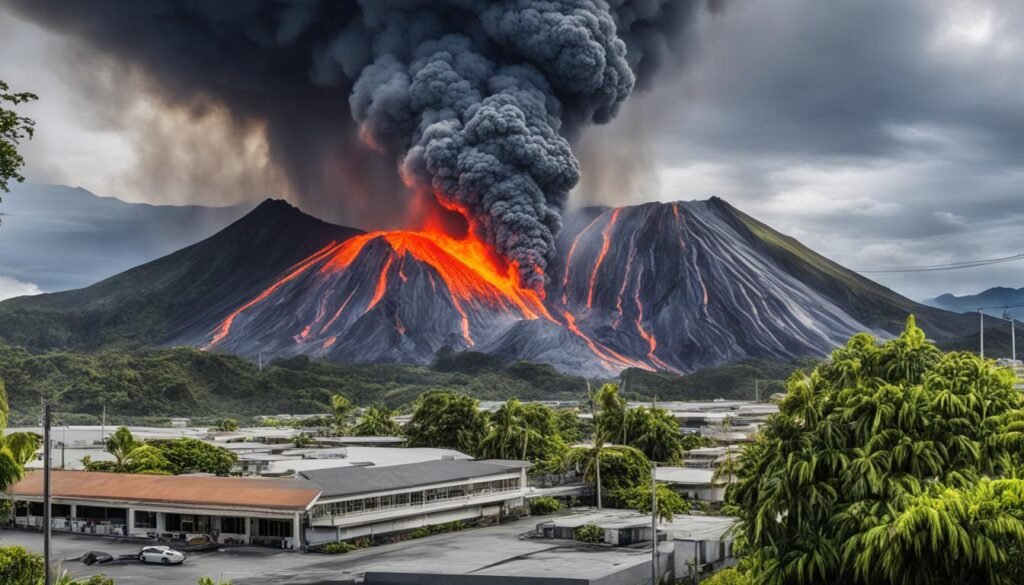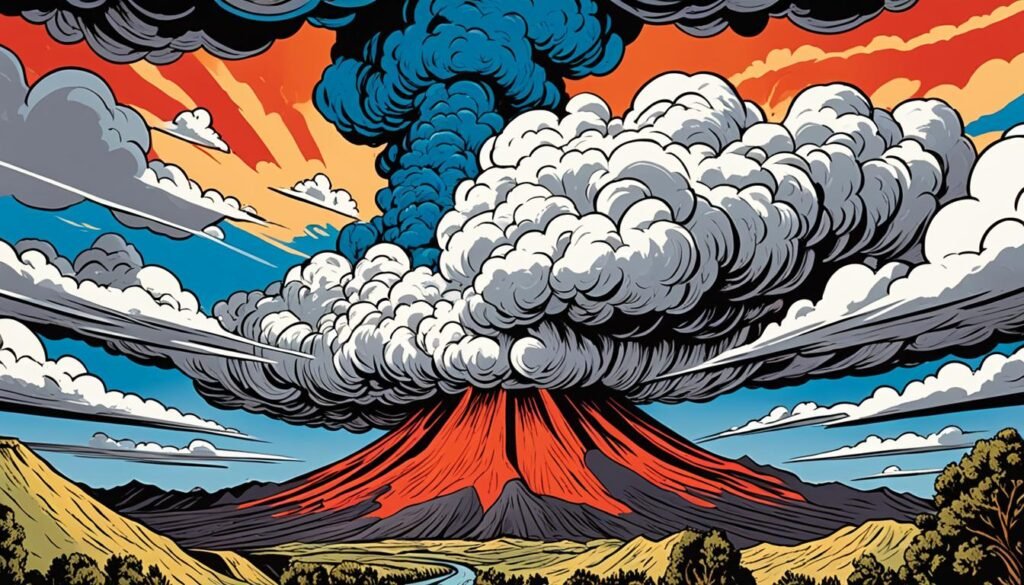In the heart of the Zambales Mountains, on Luzon island, the giant Mount Pinatubo stands. It’s an active stratovolcano that slept for ages. Yet, even before its big eruption in 1991, local legends warned of its power.
The indigenous Ayta people spoke of Bacobaco. This sea spirit, feared by all, they said would cause chaos. Mount Pinatubo’s fiery story was more than myth to them – it was a prophecy.
For generations, these stories passed. They told of Pinatubo waking up and causing great destruction. Back then, no one outside the Ayta knew these tales were predictions. But then, in 1991, Pinatubo erupted with deadly force, proving the tales true.
Key Takeaways
- Mount Pinatubo is an active stratovolcano located in the Zambales Mountains of the Philippines.
- The volcano’s violent past was preserved in the legends of the indigenous Ayta people, who spoke of a terrifying spirit named Bacobaco.
- These ancient tales foretold the eventual awakening of Mount Pinatubo and the devastating eruption that would follow.
- Prior to its cataclysmic eruption in 1991, Pinatubo was largely unknown to the general public, hidden behind dense forests.
- The Ayta people’s story of Bacobaco proved to be a chilling prophecy of the volcano’s explosive return to life.
The Mighty Pinatubo
Coordinates and Location
Mount Pinatubo sits at 15°08’30″N 120°21’00″E. It marks the spot where Zambales, Tarlac, and Pampanga provinces meet. Its location is in Central Luzon, within the Zambales Mountains.
Geographical Features
Pinatubo is a type of volcano called a subduction volcano. This means it’s formed when one tectonic plate goes under another. The Eurasian Plate slides under the Philippine Mobile Belt, creating the volcano. It is bordered by the Zambales Ophiolite Complex and the Tarlac Formation. These are areas rich in different types of rocks.
Part of the Luzon Volcanic Arc
Mount Pinatubo stands in the Luzon Volcanic Arc. This is a line of volcanoes caused by one plate moving under another. Because of this, Pinatubo has a history of powerful eruptions. It is seen as one of the most dangerous in the Philippines.
Ancestral Pinatubo: The Ancient Giant
Back around 1.1 million years ago, Ancestral Pinatubo was just starting out. It wasn’t as explosive as today’s Pinatubo. This ancient volcano was about 2,300 meters tall (7,500 feet).
Formation and Composition
Andesite and dacite rocks made up Ancestral Pinatubo. These rocks are often found in places where tectonic plates collide, like the Luzon Volcanic Arc. This tells us it was probably not as explosive as the Pinatubo we know now.
Remnants of a Bygone Era
You can still see bits of the Ancestral Pinatubo in the Tayawan Caldera. This caldera is about 3.5 km by 4.5 km wide.
Mount Dorst, Mount Negron, Mount Cuadrado, and Mount Mataba are nearby. They are what’s left of the old volcano after years of erosion. These areas help us understand more about the ancient volcano’s shape and what it was made of.

The Birth of Modern Pinatubo
Around 79,000 years ago, Modern Pinatubo woke up with a bang. It had a huge, destructive eruption that was about five times bigger than the 1991 one. This blast left behind a thick layer of pyroclastic surge material.
The eruption in 1991 was the second-largest on Earth in the 20th century. But, the eruption around 79,000 years ago was even larger. It covered the area with up to 25 cubic kilometers of material.
Cataclysmic Eruption 79,000 Years Ago
About 79,000 years ago, the big eruption happened, making Modern Pinatubo what it is today. This blast changed the whole landscape. It laid down a lot of pyroclastic surge material.
This ancient eruption was huge. It sent out five times more volcanic material than the 1991 one. It shows the massive force of Modern Pinatubo. This force stayed hidden for a long time before coming back to life.
The Legend of Bacobaco
The Ayta people tell a chilling story about Bacobaco, a spirit of the sea. At times, this entity turns into a huge turtle. It then comes onto land looking for deer, its favorite meal. In local tales, like the Sambal folklore, Bacobaco is a prominent figure. He is powerful and greatly feared.
The Terrible Spirit of the Sea
Within Ayta culture, stories about Bacobaco’s power and fear factor are common. This spirit of the sea was thought to rise from the water to cause chaos on the shore. Its main mission was to find and consume prey with unmatched determination.
The Spirit Hunters’ Pursuit
The Ayta, as skilled spirit hunters, tried to stop Bacobaco. Their king, Aglao, led these pursuits. They discovered a shield protecting Bacobaco’s back, stopping their efforts. But they didn’t give up. They turned to Wasi, the spirit of the wind. Wasi mentioned that Blit, his brother, was the only one who could beat Bacobaco, by hitting him with his tail or a toe.
Bacobaco’s Fiery Wrath
The story tells of Bacobaco’s reaction to these hunters. It leaped up Mount Pinatubo, created a huge hole at the top, and let out fire and smoke. Although it eventually retreated, the saga of Bacobaco’s volcanic legends signaled the mountain’s hidden power, waiting to be unleashed.
Premonitions and Warnings
In 1991, Mount Pinatubo showed signs of activity after being quiet for years. There were many small earthquakes and steam explosions. Sulfur dioxide gas increased a lot, meaning new magma was coming up. Sadly, most people didn’t notice these clues because the volcano had been silent for so long.

Seismic Activity and Steam Explosions
The volcano’s awakening led to small earthquakes and steam blasts. These were early signs of the coming eruption. These shakes and gas releases showed the volcano was under high pressure.
Increasing Sulfur Dioxide Emissions
One major clue was the huge spike in sulfur dioxide gas coming out. This meant new, gas-filled magma was close to the surface. But, many still didn’t realize the danger because Pinatubo had not erupted in a long time.
The Cataclysmic Eruption of 1991
On June 15, 1991, Mount Pinatubo exploded in a cataclysmic event. It was the second largest volcanic eruption on land in the 20th century. Ash columns soared up to 40 kilometers (25 miles) high. These falling rocks and debris flattened everything they touched.
Explosive Eruptions and Ashfall
The most powerful explosions sent burning ash avalanches up to 16 kilometers away. After the eruption ended, over 5 cubic kilometers (1.2 cubic miles) of material had spread out. It created a heavy ash layer over the nearby areas.
Pyroclastic Flows and Avalanches
Pyroclastic flows and avalanches from the eruption were catastrophic. They raced across land, reaching speeds of a car on a highway. These super hot gusts of gas, ash, and rocks scorched the earth, with temperatures over 700°C (1,300°F).
The Collapse and Formation of a Caldera
The eruption’s strength made Mount Pinatubo’s top cave in. This created a caldera 2.5 kilometers (1.6 miles) wide and over 600 meters (1,970 feet) deep. This event changed the landscape and marked the region forever.
Global Impact of the Eruption
The 1991 eruption of Mount Pinatubo had a big impact worldwide. It sent over 20 million tons of sulfur dioxide into the sky. This created a layer of sulfuric acid haze in the atmosphere. This haze made global temperatures drop by about 0.5°C (0.9°F) in the years 1991-1993. It also caused a temporary increase in ozone depletion in the upper atmosphere. This happened because the sulfate aerosols helped break down ozone molecules.
Volcanic Aerosols and Temperature Drops
The eruption at Pinatubo put a lot of volcanic aerosols into the air. This had a big effect on our climate. The sulfuric acid haze reflected the sun’s heat. This made global temperatures drop by around 0.5°C (0.9°F) right after the eruption.
Ozone Depletion
The eruption didn’t just cool the Earth. It also caused a temporary increase in ozone depletion. The sulfate aerosols played a role in breaking down ozone. This led to a drop in the ozone layer.
The 1991 eruption of Pinatubo shows how powerful a volcano can be. It affected the Earth’s climate and atmosphere on a global scale. The Pinatubo eruption global impact reminds us of the Earth’s fragile balance. And it highlights the importance of understanding and preparing for such disasters.

The Aftermath: Lahars and Devastation
The 1991 eruption of Mount Pinatubo went far beyond its first blast. After the eruption, heavy rains mixed with volcanic debris created lahars. These lahars were deadly and wiped out entire towns, ruined others, and even formed new ponds and lakes.
Mobilization of Volcanic Debris
The eruption left behind a lot of volcanic debris, which was a big danger. When the heavy monsoon rains came, lahars started. They ran down the mountain, causing chaos in the communities around.
Destruction of Towns and Infrastructure
The lahars from the eruption were catastrophic in the Philippines. They erased some towns and damaged others badly. Roads, bridges, and buildings disappeared under volcanic mud and debris. This disaster cut off many places and services, leading to huge economic losses.
The Ayta People’s Hardship
The Ayta people were hit very hard. They were not ready for the eruption’s effects. They lost their homes, jobs, and some lost their lives. It was because of the lahars that took over their lands. This was very tough for the Ayta community.
Pinatubo’s Violent Past Revealed
Prior to the 1991 eruption, Pinatubo kept its violent history hidden. It stayed quiet and out of sight for many years. But in 1915, the Ayta people’s stories shared a different truth.
The Ayta people lived in the Zambales Mountains and kept stories of Pinatubo’s eruptions alive. Their tales, passed on for generations, told of a giant turtle spirit named Bacobaco. This mystical being caused great destruction, hinting at the volcano’s past horrors.
The “Other Side of Yesterday”
The Ayta people knew Pinatubo’s secrets long before scientists. Stories talked about a giant turtle spirit, Bacobaco, who came from Pinatubo. This spirit would search for deer, leaving a trail of chaos behind.
The Ayta Storyteller’s Account
The Ayta tale spoke of the “terrible spirit of the sea,” Bacobaco. He took the shape of a huge turtle, causing fear and destruction. This legend gave a clear view into Pinatubo’s violent past, predating scientific discovery.

The Awakening of Bacobaco
On June 12, 1991, the Ayta legend’s spirit, Bacobaco, left Mount Pinatubo. This happened when the first magma hit the surface. After some early signs, the biggest events started on June 15th.
The Climactic Explosions
After leaving his hiding place, eruptions spread huge ash columns and more. Nineteen major eruptions were recorded. When it was over, the Mount had fallen in on itself, becoming a caldera 2.5 kilometers wide and over 600 meters deep.
Conclusion
In 1991, Mount Pinatubo exploded. It was a strong reminder of the earth’s power. This eruption surprised the world, despite the mountain’s history. The indigenous Ayta people’s legends warned about Bacobaco, a destructive spirit. Before the eruption, they told stories about it emerging from the mountain.
The eruption showed us to respect what’s beneath the earth. Its effects were felt globally. This event taught us to be ready for nature’s surprises.
Pinatubo’s eruption in 1991 changed the Philippines forever. We must learn from this and respect our world’s power. Let’s be prepared for future natural events.
FAQ
What is Mount Pinatubo?
What is the significance of the legends of the indigenous Ayta people?
What was the history of Ancestral Pinatubo?
When did the modern Pinatubo volcano form?
How did the 1991 eruption of Mount Pinatubo impact the region and the world?
What was the role of the Ayta people in the aftermath of the 1991 eruption?
Source Links
- https://en.wikipedia.org/wiki/Mount_Pinatubo
- https://plantsandrocks.blogspot.com/2012/11/
- http://www.ethnicgroupsphilippines.com/ethnic-groups-in-the-philippines/sambal/
- http://plantsandrocks.blogspot.com/2012/11/insights-from-other-side-of-yesterday.html
- https://www.aswangproject.com/sambal-mythology/
- https://knowitall.cs.washington.edu/leibniz/cleanlists/film.list
- https://morrison.sunygeneseoenglish.org/2022/04/29/cracked-foundations-and-changing-systems-the-mount-pinatubo-eruption/
- https://morrison.sunygeneseoenglish.org/2022/04/
- https://dokumen.pub/eruptions-that-shook-the-world-9780521641128-9781139109581.html
- https://www.globalwildlife.org/blog/tamaraw-tales-introduction/

